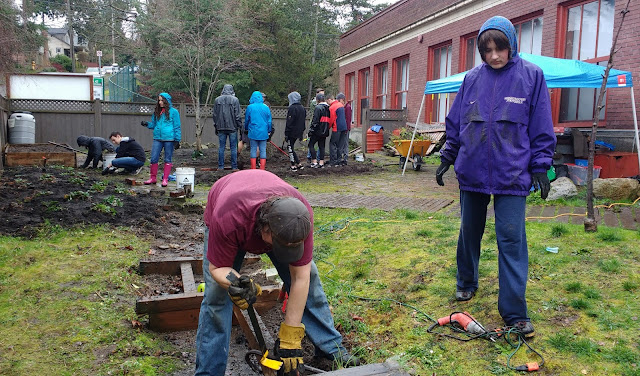We awoke to blue skies, and there was instantly a little extra spring in our steps. So we took some extra steps. Annabelle enjoyed 1.5 hours of a Girls on the Run club she recently joined, and CJ and I took a stroll around the Seattle Pacific University campus. We've driven by and through that campus hundreds of times over the last 10 years, as it's right by our house. But until today, we'd never walked it, if you can believe that.
We started at this archway.
Today, we learned it leads to the Tiffany Loop.
We also learned what year SPU was founded. It's carved into one of the bases of the arch.
As we walked around, we came across a story pole we'd only see as part of the 'nearby' map while playing Pokemon Go.
Naturally, we took the time to read the story about the story pole.
We also took the time to size up this enormous tree in the middle of the Tiffany Loop.
And we came across this nifty bike maintenance station. It had a pump next to it and tools hanging from it. What a good idea.
All in all, a pretty little campus, with nothing but brick buildings. We'll definitely stroll through there again some day.
WILD FOR FLOWERS: Yesterday, something about bees, Cheerios, wildflowers and free seeds kept popping up on my Facebook feed. Naturally, we had to check it out.
Turns out Cheerios, in partnership with Vesey's, had pledged to give away 100 million (!) wildflower seeds in a campaign to help #BringBacktheBees.
Why bother? Well, according to the Cheerios site, 1 in 3 bites of food we eat is made possible by bees and other pollinators, and 42% of bee colonies in the U.S. collapsed in 2015.
When I hopped on their site (http://www.cheerios.com/bringbackthebees) yesterday, the meter said they'd already reached their 100 million goal, but it let me enter my data anyway and said some seeds were headed our way.
This evening when I checked again, things were a bit different. ...
So the bad news is, no more free seeds. The good news is, they are giving away 1.5 BILLION seeds. That's so cool. We can't wait to receive ours!
They also posted a map of where the seeds are being shipped.
MUD-DAY: I never did post about our Monday. It involved heavy duty physical labor. For six hours. In the frequently pouring rain.
Demolition, digging, dump runs, all sorts of fun. We were working on improving a school garden alongside a service group of teens and young adults from Oklahoma, believe it or not. There were probably 22 or so of us in all. While it's true many hands make light work, there was major work to be done, so it didn't feel all that light!
We had the added bonus of having a dead battery during the dump run. Good, good times.
INSPIRING: As part of the social studies club they belong to, the kids are producing profiles of people they admire. Here's CJ's choice ...
Faster-Than-Light: Meet Miguel Alcubierre
Have you ever dreamed of travelling
faster-than-light to other planets, star systems, or even galaxies?
Unfortunately, our current space propulsion systems would take far too long to
get to far-off places in space. However, one man has a possible solution: Dr. Miguel Alcubierre
Moya (better known as Miguel Alcubierre), Director of the Nuclear Sciences Institute
at UNAM, is a Mexican theoretical physicist.
Miguel Alcubierre is best known
for proposing the Alcubierre Drive in 1994, a theoretical propulsion system
that would allow spacecraft to travel faster-than-light.
Miguel Alcubierre
was born on 28 March 1964, in Mexico City. In 1988 and 1990, Alcubierre
received degrees from the National Autonomous University of Mexico, after which
he traveled to Cardiff University, in Wales to attend graduate school. In 1994,
Miguel Alcubierre received his Ph.D from Cardiff, through study of numerical
general relativity.
Later that year, Dr. Alcubierre wrote “The Warp Drive: Hyper-fast travel within general relativity,” the
original article in which he proposed the Alcubierre Drive. The Warp Drive was published in science
journal Classical and Quantum Gravity.
In The Warp Drive,
Dr. Alcubierre describes the Alcubierre Drive as being a system in which the
space in front of a spacecraft is compressed, and the space behind the spacecraft
is expanded. The Alcubierre Drive would theoretically let a spacecraft travel
at faster-than-light speeds.
In 2012, Dr. Alcubierre was appointed as the Director of the
Nuclear Sciences Institute at the National Autonomous University of Mexico
(UNAM). In 2016, Dr. Alcubierre was reappointed.
Sources:














No comments:
Post a Comment